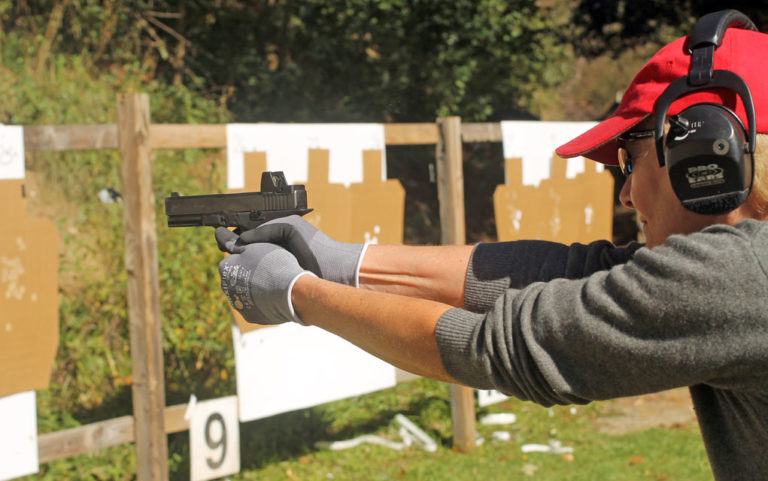
A groundbreaking study compared red dot sights with conventional iron sights, green-dot laser sights, and slide-mounted red-dot sights with and without backup iron sights (BUIS) on the pistols. Which sights are best for concealed carry?
What the study showed on concealed carry optics:
- The study found optics weren't significantly better than iron sights at 5 to 10 yards.
- However, at longer ranges, there is a 10- to 20-percent improvement with an optic.
- Time was the biggest factor in muting the effectiveness of optics and lasers.
- When visible, shooters spent added time on placing a shot exactly with a laser sight.
- Trying to find the dot is the biggest hurdle to an optic achieving a fast, aimed shot.
- Rehn finds iron backup sights a must if shooters turn to either aiming solution.
Advanced practice in any discipline has to take into account the latest trends. Concealed carry is no exception. One recent trend is in carry optics.
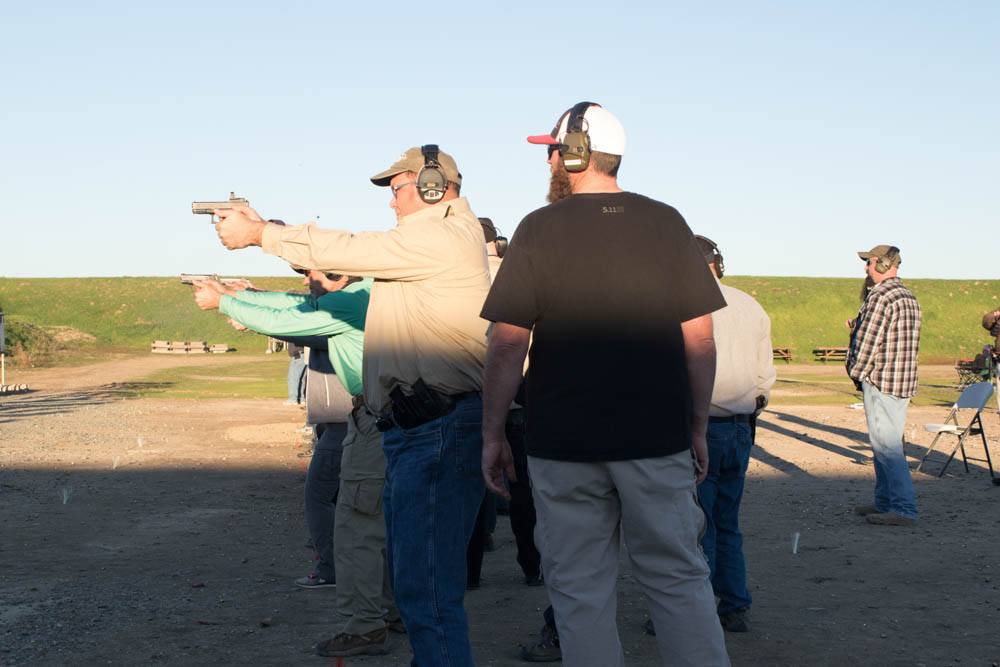
Red dot electronic sights captured the appreciation of bullseye target shooters as soon as they came out. Brian Enos at Bianchi Cup in 1984 and Jerry Barnhart by 1990 in IPSC, the International Practical Shooting Confederation, pioneered their huge popularity in speed shooting and practical shooting competition. As with computers and telephones, the technology eventually became sufficiently miniaturized that it could fit on a concealed carry pistol, and “carry optics” were born. We are seeing more and more of them at classes, most often in the hands of tech-oriented millennials and geezers like me with fading eyesight. What do they bring to the table?
To answer that question specifically for this book I turned to a colleague who, to my knowledge, has done more scientific study on this topic than anyone else on the planet. Karl Rehn is a master instructor and owner of KR Training in the Austin, Texas, area. I was one of the many who took part in his ground-breaking comparison of carry optics with other sighting systems. You can hear him discuss it in more depth on the ProArms Podcast at proarmspodcast.com.
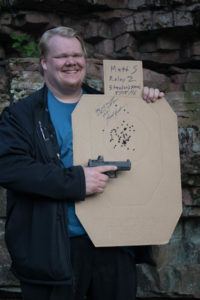
Karl’s study encompassed 118 shooters over a year and a half to examine the red dot sight’s practicality vis-à-vis conventional iron sights, laser sights projecting a bright green dot onto the target downrange, and slide-mounted carry optics type red dot sights with and without backup iron sights (BUIS) on the pistols. The study was supported by university grant funding.
Karl explains, “My background is engineering and tech, 23 years evaluating security systems. I look at gear through that lens. When something new comes out, how can we measure whether it’s better?”
Says Karl, “A lot of the data we had before involved United States Practical Shooting Association (USPSA, the American arm of IPSC) competition in the 1990s, and red dots on military rifles. The big difference is these were all frame-mounted sights, not slide-mounted guns, and those guns’ sights didn’t move every time firearm cycled. Also, both dot and tube were typically larger on those. Carry optics are different, smaller. A lot of people think carry optics will be the same as what’s found on an ‘open gun’ in pistol competition or on a rifle. They’re not.”
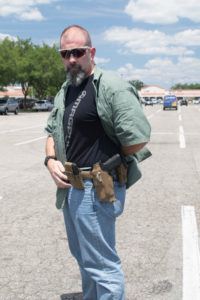
Rehn is proud of the impartiality of his test. “We had no equipment donated by vendors. Another study was done in Northeast funded by Trijicon. They didn’t have every shooter shoot all the guns. We had every shooter in our test shoot all four guns on exactly the same test. We randomized the order of guns so there would be no bias; 25% shot each gun first. We did multiple trials with each shooter to level out the data. It took about 15 minutes per shooter. We had total novices to IPSC grandmasters and career trainers, a broad spectrum that allowed us to break out different categories.”
Rehn continues, “Our tests didn’t show the carry optics to be significantly better; many people struggled to find the dot. Some of the things that would have made red dot look better, we didn’t test, such as long range. We teach primarily defensive pistol; on a carry gun any accessory must not degrade skills from 3-10 yards, with the first shot probably the most important one. We did one shot at 5 yards and one at 10, all one-shot drills from low ready. Difficulty of getting first shot on target was a focus. We’re talking about life-safety equipment.”
He added, “We used M&P COREs. The carry optics were Trijicon RMRs, with and without tall backup sights. We had several of these in different configurations, one of which was with the Streamlight light/laser unit under the barrel. All guns were the same as far as barrel, trigger, etc. Each shooter had 1.5 seconds to make their shots. Most with iron sights were able to do that regardless of skill level. We did it two-hand and also dominant hand only. We did three trials per test type, recording raw time and points, on IDPA targets, and scored like IPSC: five points for a center hit, then three points for the next zone out, then one point for the outer zone as in USPSA Production division. We didn’t study low light or shot-to-shot recovery or multiple targets or long range; there’s plenty of room there for further study.”

Recalls Karl, “Roy Stedman, a Grandmaster shooter and R&D engineer, looked at the Steel Challenge years ago, which was noteworthy because shooters fire iron sight and red dot on similar courses and stages. There, longer range targets and basically one shot per target, he saw a 10-20% improvement with frame-mounted red dots. It shows for sure they do allow for improved shooting. That data does exist.”
How It Works
Karl explains, “The number one problem people had was that when you have irons you’re adapting to what you see as gun comes up to target. You see sights and top of gun and target and adapt as gun is coming up. With the green projection laser, if you can find the laser on anything it’s very natural with target focus to drive the laser dot to the spot you want to hit. With slide mounted red dots, what happens is when you bring gun up you see no dot, there is no indicator to tell you where the dot is. You move gun and head to find it. It takes time. Many of the pioneers in this, like David Bowie, the gunsmith who worked on this many years ago, started putting BUIS (backup iron sights) on pistols. Getting irons on target lets you see the dot. Most who have worked with these advocate tall, suppressor-height irons.”
He continued, “Last summer I committed myself to earning Grandmaster in Carry Optics in USPSA. From May to August 2016 I shot nothing but Carry Optics. I made Grandmaster. What I learned was that for the most part I looked for the backup irons and found them essential. I consider BUIS mandatory.”
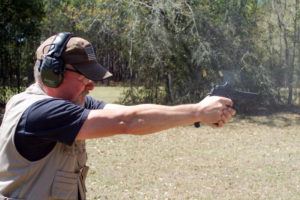
Karl said that perhaps the biggest thing that came out of the study was that so many shooters ran out of time trying to find the dot without iron sights. He says adamantly, “Any skill you can’t do ten times out of ten on demand, you don’t own and can’t count on under stress. Some shooters claim, ‘If I can’t see the dot, I’ll just tube it,’ that is, line up the window with brown of target. I measured that deflection. With an RMR with just the window in the center of an IDPA target without the dot visible, at best at 5 yards your field of view through the window is 8”. We found the window four times bigger than width of rear sight notch. So, here’s the deal: if you bring your carry optic up and can’t see the dot, it is physically impossible to put a shot in the A-zone unless you’re pointing high right and jerk low left. Beyond 2 or 3 yards, tubing won’t work. You have no way of knowing how far the sight is misaligned if you can’t see the dot.”
Breakdown Of Results
The Rehn study had 118 participants, from 19 to 76 years old, male and female. He broke the participants into four categories of experience: (1) Novice, with no significant training or experience; (2) Had passed Texas Concealed Handgun License (CHL) shooting test at 90% or better; (3) Anyone with anything beyond CHL level, which according to a separate body of Karl’s research encompasses about 1% of those with carry permits; and (4) Instructors/high level shooters/those with at least 40 hours of training/B-class or higher competition shooters.

Karl defined an acceptable outcome as how many got at least a 5 to 3 point hit. 94% did so with iron sights. With green laser it was 90%. Hybrid (with both RMR and BUIS) were 84% and 76%, respectively. The test saw a lot of people run out of time, or fire an unaimed shot when they knew time was almost gone, when working with the carry optic as their only index.
One-hand versus two? “One-handed didn’t really change the time for the first shot more than a few percentage points,” Karl determined.
He added, “One thing we ended up doing, we took iron sight scores as the participants’ basic skill indicator. We moved some based on iron sight score to better sort them by skill level.” He was able to determine different effects at different skill levels. Novices with irons averaged around 80%, with laser 70% plus, and less with red dots. Instructors did better with the slide-mounted red dot than with green laser or hybrid. Intermediate, post-CHL shot about as well with laser and hybrid with red dot. More experienced shooters struggled with the laser because they’re used to looking at sights, not for laser dot on target.
Rehn frankly noted, “A weakness of the test was that no one did a 200-round familiarization with the dot. Last summer, USPSA had Production and Carry Optics National Championships, many competitors using the same gun for both. This provided a fair amount of data since many stages were exactly the same. There were no dramatic changes in hit factors. Even at top shooter level, we didn’t see the 10-20% improvement we saw with frame mounted optics. At best, scores were 5-10% higher with carry optics. Don’t expect miracles. At best you’ll get 10%, in reality probably less than that.”

It seems logical that older shooters with older eyes would benefit most from carry optics, but Rehn’s study puts this hypothesis in question. He observed, “We did not really see a significant improvement in that regard. We didn’t see older shooters any better or worse than younger. If you can’t focus at close distance, green laser works quite well, as good or better than trying to focus on slide mounted dot or irons. My advice to older shooters is to try the less expensive green laser first, which also still leaves your regular iron sights usable. I really think green lasers may be under-rated.”
It should be noted that Rehn had nothing personal to prove with this study. “As someone with zero fiscal interest in selling any sights or training specific to any type of optic, I tried to look at it with less bias than some, who make money from the proliferation of carry optics,” he says. “ Lasers are carried by far more people than carry optics, which I for one think should be allowed in competitions where they are currently banned.”
Bottom Line
Some of Karl Rehn’s conclusions from the eighteen-month study? “At 5 to 10 yards iron sights are still better for most people. The green laser is a very close second. If you’re going with carry optics, put backup irons on the pistol. Baseline your performance with similar drills yourself. Use drills that are hard for you to max at 100% to better measure relative improvement. You have to answer the question, ‘Do I actually shoot this better?,’ based on rational analysis and logic. If it works better for you, use it; if it doesn’t, don’t.”
Karl Rehn does not personally carry optical-sighted guns. He does like the Veridian light/green laser combo for carry. He shot the entire 2016 Rangemaster event using green laser exclusively, and came in 7th out of over 200 serious shooters despite a time-consuming malfunction. “John Hoelschen has done a great deal of work with carry optics in low light in force on force,” Rehn comments, “and he likes the ability to look through the tube and watch people’s hands. He carries a gun with a red dot on it and shoots it very well.”
This article is an excerpt from Gun Digest Book of Concealed Carry, Volume 2: Beyond the Basics.
Expand Your Knowledge on Concealed Carry
- Best Concealed Carry Pistol [Range Tested]
- Best Concealed Carry Pistol for Women
- Best Concealed Carry Pistol Upgrades
- CCW Insurance – Concealed Carry Insurance Options
- Best Concealed Carry Optic – Results from a Groundbreaking Study

Next Step: Get your FREE Printable Target Pack
Enhance your shooting precision with our 62 MOA Targets, perfect for rifles and handguns. Crafted in collaboration with Storm Tactical for accuracy and versatility.
Subscribe to the Gun Digest email newsletter and get your downloadable target pack sent straight to your inbox. Stay updated with the latest firearms info in the industry.

![Best Concealed Carry Guns In 2025 [Field Tested] Wilson Combat EDC X9S 1](https://gundigest.com/wp-content/uploads/Wilson-Combat-EDC-X9S-1-324x160.jpg)


![Best 9mm Carbine: Affordable PCCs [Tested] Ruger Carbine Shooting](https://gundigest.com/wp-content/uploads/Ruger-Carbine-Shooting-100x70.jpg)
![Best AR-15: Top Options Available Today [Field Tested] Harrington and Richardson PSA XM177E2 feature](https://gundigest.com/wp-content/uploads/Harrington-and-Richardson-PSA-XM177E2-feature-100x70.jpg)
